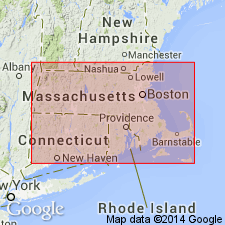
- Usage in publication:
-
- Lobsterville Sand
- Modifications:
-
- Named
- Dominant lithology:
-
- Sand
- AAPG geologic province:
-
- Atlantic Coast basin
Summary:
The Lobsterville Sand is here named at Martha's Vineyard, MA. It is part of the Gay Head moraine, composed of thrust plates made up of remnants of Coastal Plain sediments which were stacked up during Pleistocene glaciation. It consists of light-yellow to gray, medium to coarse, clean, shelly sand, cross-bedded, with broken mollusk shells. Overlies the Devils Bridge Clay. Thickness is 3.5 m. Age is early Pliocene, based on fossils.
Source: GNU records (USGS DDS-6; Reston GNULEX).
For more information, please contact Nancy Stamm, Geologic Names Committee Secretary.
Asterisk (*) indicates published by U.S. Geological Survey authors.
"No current usage" (†) implies that a name has been abandoned or has fallen into disuse. Former usage and, if known, replacement name given in parentheses ( ).
Slash (/) indicates name conflicts with nomenclatural guidelines (CSN, 1933; ACSN, 1961, 1970; NACSN, 1983, 2005, 2021). May be explained within brackets ([ ]).

